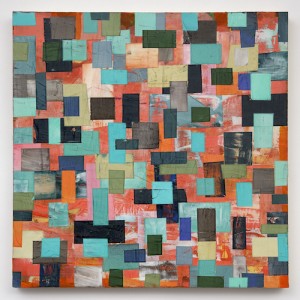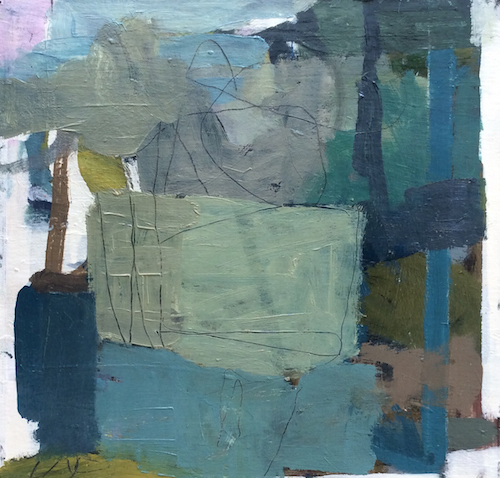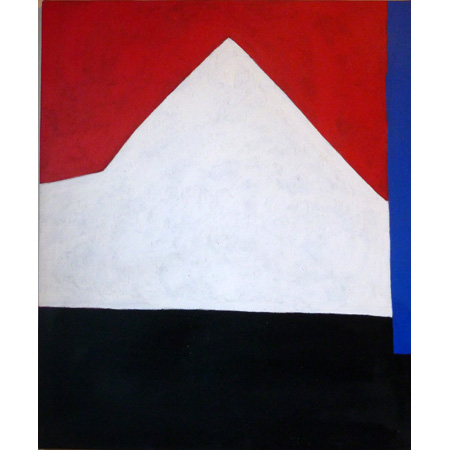(HUDSON, N.Y.) – “Color Theory”, a group exhibit featuring the work of local artists Vincent Pomilio, James O’Shea and Stephen Brophy, opens this weekend at Carrie Haddad Gallery, with a reception on Sunday, October 11, at 2pm. The exhibition emphasizes art as process rather than product, the shift from realism into abstraction, and the role of color in achieving these effects.
Most of recorded art history is dominated by realistic painting, a highly polished, academic style of brushwork where little is left to the imagination. A push to express more than what can just be seen sparked a reinterpretation of the painting process. Art became the activity of creating rather than the finished product and, with this, color was used as the tool to capture the breadth of the artist’s vision. Its combinations were used to produce a visual effect that translated representational art into an abstract language juxtaposing color, line, and shape. This shift from the naturalistic into abstraction is none better characterized than with the work featured in “Color Theory”.
Inspired by the natural world, Vincent Pomilio produces unexpected color combinations using mixed media on canvas, paper, or wooden panel. Starting with a grid, the artist proceeds to deconstruct it. Several layers are created with a mixture of Kolcaustic plaster, marble dust, and acrylic paint. One thing leads to another, the artist working intuitively, turning the piece a quarter turn until there is nothing he can do to make it better. From there a process of rubbing and sanding the layers is repeated after the materials are applied. The final finish is refined beeswax burnished to a smooth surface.
“If you see it, it is there”, says Pomilio, as he challenges the viewer to find the recognizable shapes and images that are left behind as a result of his process. “One shape flows from another, and then another, until there is a pulsating energy of interacting elements. Worlds of refined, chaotic movement are animated by color.” New additions to the Big-Little series, which the artist began in 2009, will be exhibited alongside recent work on panel and linen made during an artist residency in Florida. Pomilio pursued graduate studies at the Tyler School of Art in Elkins Park, PA and New York University in Manhattan. He has been featured in group and solo exhibitions internationally.
James O’Shea returns to Carrie Haddad Gallery with his masterful color studies in oil, encaustic and other mixed media. His compositions of layered colors and shapes, seeming architectural and yet organic, are inspired by experiences near his studio on the Hudson River. The artist’s interest in the energy surrounding nature’s changing of seasons is clear as each color and shape come to represent a particular time of day or year. O’Shea finds revelation in observing the world while it’s deep in hibernation during the winter months. With foliage shed from the trees, therein lies nature’s defining qualities – branches that are finely etched against blue and gray winter skies, animals that are exposed to the elements, their tracks in the snow leaving proof of scurried movements. These characteristics of the land can only truly be known when it is cold and summer’s distractions are put to rest. O’Shea allows loose brush strokes to mimic the bare bones structure of the landscape, finding perhaps his greatest pleasure in supplying the color. Palettes shift from a deep, blue-ish grey in the late winter to a bright, candied pastel in the early summer. O’Shea suggests the most delightful and unexpected color schemes; intense hues of blue are interwoven with bouts of rich maroon, a pairing that urges preparation for the cooler months.
Audiences may know Stephen Brophy best for his vividly colored landscapes and paintings of residential buildings. Yet several bodies of work completed in the early to mid 1990s showcase a very different style of abstract painting for the artist. With canvases measuring over 5 feet tall, Brophy applies flat blocks of color to his surfaces with barely visible brush strokes, an application oftentimes associated with the color field paintings of the 1950s. Unlike in abstract expressionism where color and pattern trump geometry and form, Brophy allows the borders created by the juxtaposition of his colors to define a pictorial image. He then titles his paintings to further aid the viewer in identifying the real world object being depicted. The combinations of color and geometry tell a story through a unique ability to set a mood via a grand scale and bold primary or pastel color palette. Non-textured, flat blocks of black, red and white are stacked in the painting “Barn”, the peaked angle of white being perhaps the sole indicator that this could be perceived as the outline of a roof. The viewer’s brain is prompted to fill in the missing pieces to satisfy any real world associations. Other paintings are perhaps less obvious; Brophy’s signature line that curves and divides the canvas horizontally or vertically is a reoccurring motif that could represent the horizon separating land and sky or the frontiers of landmasses and weather fronts. A native of New York City, Stephen Brophy is a self-taught artist and has produced varied bodies of work including paintings, drawings, prints and sculpture for the past 50 years.
Contact the gallery at (518) 828-1915, or visit Carrie Haddad Gallery. Located at 622 Warren Street in Hudson, NY, the gallery is open daily from 11 – 5pm, & Sundays from 12-5pm.



